There is a Moore’s Law for cars, too.
Like computers, they get faster – and cheaper – with each new generation.
BMW’s new 5 Series is a case in point. It is now almost as large as the 7 Series used to be – and it offers many of the amenities (including gesture control, massaging seats and a 1,400 watt, 20 speaker audio rig) that are available in the current 7 Series, which used to keep such goodies to itself.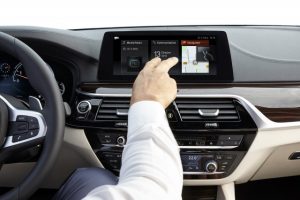
Which helped to justify its much higher price.
Now there is overlap. Not of price – the new five sedan stickers for $30k less to start than BMW’s flagship Seven series sedan.
But of size, presence, performance and equipment.
People eyeballing the Seven may cast more than a passing a glance at the new Five – as well they should.
The 5 Series sedan is nominally BMW’s mid-size luxury-sport sedan – but it is almost a full-size car now and the emphasis has been moving more toward luxury (and technology) and away from sportiness for several years. This all-new version is the most luxurious (and technology-laden) 5 Series BMW yet.
As mentioned above, it is also the largest 5 Series yet.
The Five is available in both rear-wheel-drive and all-wheel-drive versions, with your choice of turbocharged four cylinder or turbocharged in-line six cylinder engine.
Prices start at $51,200 for a rear-wheel-drive 530i powered by the 2.0 liter turbocharged four; adding xDrive all-wheel-drive raises the MSRP to $53,500.
The more powerful 540i – with the turbocharged 3.0 liter in-line six, stickers for $56,450 for the rear-wheel-drive version and $58,750 for the AWD-equipped, xDrive version.
WHAT’S NEW
The 5 Series is all-new for 2017.
Almost a Seven – except for the price.
Bigger – but not beefier. Larger/roomier 2017 Five actually weighs less than previous/smaller Five due to extensive use of aluminum body panels.
Couple inches more backseat legroom than Benz E300 sedan.
Available with more than just a four (unlike the four cylinder-only Mercedes E300 sedan).
Car almost drives itself – literally.
Four cylinder-powered 530i is a little under-engined for the money. It’s not slow – but many family sedans that cost half as much are just as quick.
Audi A6 costs thousands less – $47,600 to start; $49,800 with Quattro AWD. And has a comparably roomy backseat.
Add a few options and a Five can cost almost as much as a Seven.
Shifting emphasis from Ultimate Driving Machine to a Machine That Drives Itself.
UNDER THE HOOD
It’s a measure of just how much pressure the car companies are under to squeeze out ever-higher miles-per-gallon that cars like the Five – which start around $50k – comes standard with a four cylinder engine.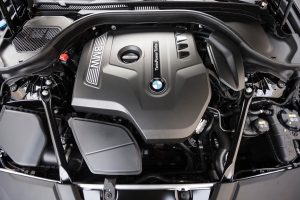
These used to be considered economy car engines – and in a way, they still are.
Well, they are economical.
The 530i’s 2.0 liter turbocharged engine carries an EPA rating of 24 city, 34 highway; during a weeklong test drive, I never averaged less than 28 MPG. For reference, this is close to the mileage you’d get out of an economy car like a Toyota Corolla (28 city, 35 highway).
But the Corolla’s four cylinder engine isn’t turbocharged and doesn’t make 248 hp and 258 ft.-lbs. of torque. Nor is a Corolla capable of accelerating from rest to 60 in about six seconds flat.
It’s more like nine for the Toyota.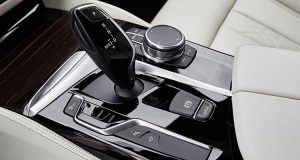
So you get what BMW accurately styles efficient performance. And better performance than a Benz E-Class sedan – which also has a turbo four (2.0 liters and 241 hp) but which is also lugging around more weight and so needs a full second longer to get to 60. That is on the verge of Iffy for a car with a starting price close to $50k.
The Benz is also not as efficient: 22 city, 30 highway for the rear drive model (22/29 with the optional AWD system).
And – the Big Thing – it doesn’t offer an upgrade.
The 540i comes standard with a 3.0 liter DOHC straight six – BMW’s hallmark engine – with two turbos, 335 hp and the capability to reach 60 MPH in 4.9 seconds. This version slaughters the Mercedes E300 and also beats the supercharged V6 version of the Audi A6 – another cross-shop – by a few tenths (it gets to 60 in 5.3 seconds).
Whether you go with the 2.0 liter turbo four or the twin-turbo six, the standard and only available transmission is an eight-speed automatic. Drivetrain responsiveness (and suspension settings) can be fine-tuned for Comfort, Sport, Normal and Eco operation via buttons to the left of the gear selector on the center console.
When you pick Sport mode, the LCD gauge cluster automatically transforms to racy red backlit, with a large digital tach replacing the traditional-looking analog gauge that’s present when in Normal mode. 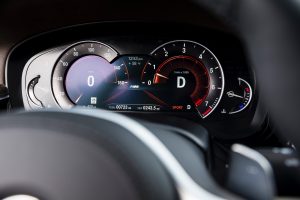
Unfortunately, BMW will not be sending the 530d – with its extremely fuel efficient – turbo-diesel engine to the United States, because of the cost/hassle of making diesels EPA-compliant.
The issue isn’t that the diesel is “dirty.” No new car or car made within the past ten years for that matter – whether gas-engined or diesel-engined is “dirty.” It’s that the EPA has become as an unreasonable as an embittered ex-wife – basically demanding zero emissions (or within a fraction of that, literally) in order for a car to be legal to sell.
This is almost impossible for any internal combustion engine to manage – and modern diesel engines are particularly challenged because they produce fractionally more of certain exhaust byproducts, such as NOx, than gas-burning engines. This has made them pariahs in the United States – notwithstanding that they are commonplace in Europe – where double-digit gains in fuel efficiency are considered more important than a fractional difference in NOx emissions.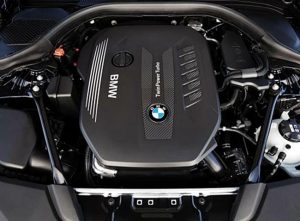
It’s not just the diesel we don’t get.
In Europe you can buy a 520i – which has a slightly less powerful version of the 2.0 liter four, but it’s paired with a manual transmission. This naturally appeals to drivers – but Americans are apparently less and less interested in that (hence the autonomous tech) but it’s also because of the fuel efficiency fatwas. There is a slight – generally, it’s about 2-3 MPG – fuel efficiency advantage to be gained by going with a modern (and precisely programmed to shift at exactly the optimum moment) eight-speed automatic vs. a shifted-by-you (and perhaps not always optimally) six-speed manual transmission.
This difference is trivial, certainly, to the owner of a $50k car – whom we assume can comfortably shoulder spending an additional $10 a month or so on gas in exchange for the driving enjoyment of shifting his own gears. But from a corporate perspective, that 2-3 MPG difference per car cannot be overlooked because of the effect, writ large, it has on the corporation’s fleet average fuel economy stats.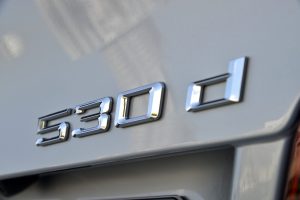
In Europe, they don’t hit car companies with “gas guzzler” penalties for not meeting their “fleet average” mandatory minimums; they just tax the living daylights out of gas. But the upside is, people are still free to buy cars that are maybe a bit less fuel efficient because they have manual rather than automatic transmissions.
Here, CAFE compliance lords over everything.
And that is why no third pedal for us.
The autonomous (self-driving) cars are not coming – they’re here. And oddly enough – it’s “driving machines” like this BMW that increasingly drive themselves.
Engage Skynet – whoops, the Lane Keeping Assist and Active Cruise Control. The car not only accelerates and brakes all by itself – coming to a complete stop, if need be, and then resuming speed without you even having to ask it to.
It can steer all by itself, too.
And, parallel park. With you even being in the car. Really. Just push a button on the “smart” remote key fob.
You maybe remember the episode of the original Star Trek series in which Captain Kirk is replaced by a computer – ironically enough, named the M5.
Captain Kirk became Captain Dunsel – a meat sack irrelevance.
We are not quite there yet – but getting closer.
There systems don’t take over – yet – but they are pushy and peremptory, as much as they are being marketed as soothing and helpful. For example, if you decide to change lanes without signaling first – a reasonable thing to do if there’s no traffic around, just as it is reasonable to not wait endlessly like a lobotomized drone at a red light that never changes – the steering will fight you. It will try to steer you back into the lane you are trying to swap out of of.
It’s a light tug, but a tug nonetheless.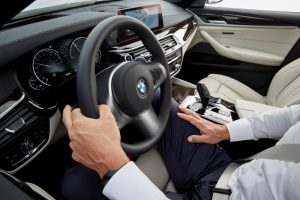
I don’t think it is possible to turn this off, either.
It’s of a piece with the peremptory turn signal programming most new cars have that will not let you manually blink just the once . If you touch the signal, it will blink three times at least.
For saaaaaaaaaaaaaaaafety.
Just so, the car won’t let you Reverse if the door is open and turns down the radio volume when you are reversing – and forget burnouts.
Increasingly, our cars dictate terms and conditions to us. We morph into passive passengers, along for the ride.
The turbo four is another sign of the times. It’s a fine engine – capable of spinning to 7,000 RPM – and 248 hp isn’t soggy. But a big – bordering on full-size – luxury-sport sedan like this one would have come standard with a six just a few years ago. Just as big cars used to almost aways come with V8s (but lately come standard with sixes).
It’s a chill harbinger of what’s coming. Which is ever-smaller engines, increasingly tandemed with hybrid powertrains. The 2018 Five will come standard with exactly that – the 2.0 engine paired with a battery and electric motors, with plug-in capability.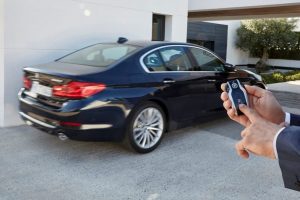
This is a result of German regulatory fatwas – which include internal combustion No Go Zones. Places only “zero emissions” electric cars and hybrids that can operate as electric cars for the duration of the trip – may go.
It will be a saints-preserve-us miracle if BMW can continue to sell the six at all.
Note that Mercedes has given up already .
The six, then, is the way to go. Not because the four is lacking. It’s just not abundant. A six second run to 60 is right there with . . . a V6 Camry. And step behind a V6 Accord. Both of which are half the price of the Five.
Which ought to be able to put distance between itself and them proportionate to its price tag. Which it can, come the corners. The M5 interferences notwithstanding, this BMW can still be driven. Which is why it’s such a shame that they are working so hard to make the driver an irrelevance.
Anyhow, the six has abundance worthy of the car – and it sounds right, too. The four makes almost no sound at all.
And it’s only a slight price bump to get the six – once you’re already pondering a $50k car. Plus, it’s a signature engine. A straight six is unique. In feel and sound and name, too. That is worth something.
Meanwhile, it seems that every car – not just high end cars – is powered by . . . a 2.0 liter turbo four. They are becoming as common as inline fours in the bike world – and for kinda-similar reasons. They meet the criteria. In a bike, an inline four is shaped right for speed – and makes the power needed for speed.
In a car, a 2.0 four is exactly the maximum displacement allowed under Euro emissions/C02 regs, before punch-in-the-throat taxes kick in.
Danke, German Uncle.
This new Five is – literally – almost a Seven.
The previous Seven.
Before it was supplanted by the current model, the previous Seven was available in both standard and long wheelbase versions – the standard wheelbase model being 199.8 inches long overall and riding on a 120.9 inch wheelbase.
The new Five is 194.6 inches long overall and rides on a 117.1 inch wheelbase – making it about one Snicker’s bar less long overall than the previous, regular wheelbase Seven. It has only slightly less rear seat legroom (36.8 inches vs. 38.9) and like its slightly bigger (and lots more expensive) brother, its exterior bodywork is made almost entirely of aluminum now. The doors, trunk lid, hood and front fenders. Only the rear quarter skins and underlying unibody are still made of steel – and it’s lightweight “carbon core” steel – which is how the Five got bigger but not heavier.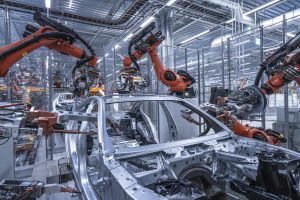
The rear-drive version slides in just under 3,900 lbs. – while the xDrive version comes in just over 4,000 lbs.
To give you some perspective, a roughly same-size Seven (previous generation) weighed 4,344 lbs. to start (rear-drive version).
The car looks like a heavy-roller, though.
If you stand in front of it, the hood seems wide and long – which it is. The front fenders have brushed metal scallops cut into them, just like the Seven. Parked in isolation, it could pass for a Seven. It is only when parked next to a new Seven – with its obviously longer back doors – that the Five looks like something a bit less than a Seven.
But it is still an impressive-looking car.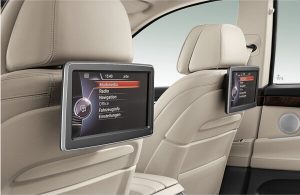
And impressively equipped.
Amenities such as dual 10.2 inch backseat DVD monitors, a 16 speaker, 1,400 watt Bowers & Wilkins audio rig, massaging seats and BMW’s twirl-your-finger Gesture Control – which lets you adjust the stereo and pick up or ignore calls without actually touching anything – things that used to be Seven series exclusives – are now Five series availables.
There’s so much available, in fact, that there’s very little missing. One of the few things the Seven still offers that the Five does not is a rear seat Executive package with reclining/massaging/heated back seats.
Maybe next year.
Well, that and a V8.
The new Five also has a full-size car’s trunk: 18.7 cubic feet. It is worth mentioning that the Five’s trunk is actually larger than the current Seven’s trunk (18.2 cubic feet) and much larger than the hybrid Seven’s trunk (which is about 13 cubic feet; the battery pack has to go somewhere).
One thing that hasn’t gotten bigger are the cupholders – and you only get two, located not-so-conveniently ahead of the gear shifter, making for delicate coffee-cup maneuvering. These cupholders are also shallow and so more spill prone.
It is a German Thing.
Another area where the Five is small is the center console storage cubby. It is beautifully trimmed out with a two-piece top with sections that can be opened individually. But underneath, there is room for not-much. It is ironic that big luxury cars often have the smallest storage compartments.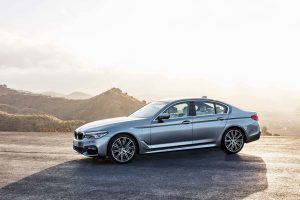
THE BOTTOM LINE
It used to be that the Seven was so overwhelmingly Rich Stuff, so far up above the rest of BMW’s lineup, that you almost needed binoculars to see it.
The new Five either takes it down a notch – or raises itself two or three.
If you like what you’ve found here, please consider supporting EPautos.
We depend on you to keep the wheels turning!
Our donate button is here.
If you prefer not to use PayPal, our mailing address is:
EPautos
721 Hummingbird Lane SE
Copper Hill, VA 24079
PS: EPautos stickers are free to those who send in $20 or more to support the site. 



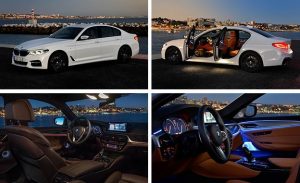
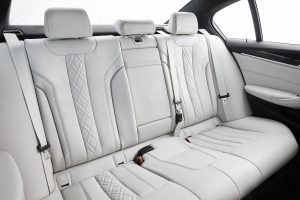
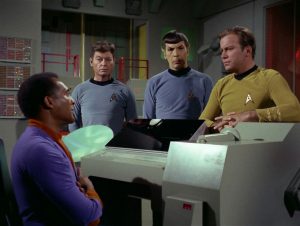

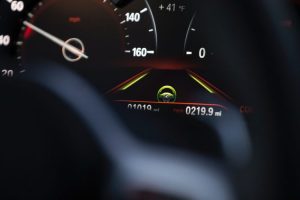
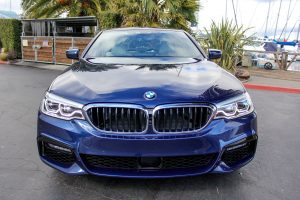
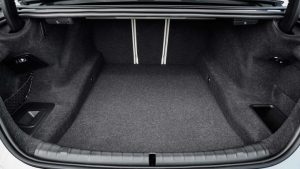






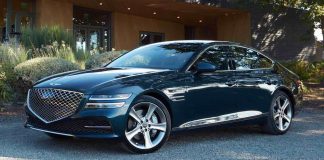
One more thing to keep in mind is that the market for these big luxury cars is shifting eastward, and in Asia rich people usually have a driver, so manual transmissions, big cup holders and storage cubbies are not important for them.
Hi Escher,
Sigh… you’re right. It is bleak. The Twilight of the West is upon us. But perhaps it will turn out for the best. Perhaps the peoples of the east are the ones best able to carry the torch. They seem not have the selbsmordt instinct that increasingly defines the West.
PS: I am test driving the 2017 Mazda3 this week…
A 4.4 liter V-8 is avaialble in the M550i xDrive, which is part of the 5-series line up (not in the separate M line). https://www.bmwusa.com/byo.html#!/build/color/dcsw7cst
The steering wheel tugging thing seems really like a bad idea. It will lead to oversteer, as people start pulling harder back the other way.
The last thing in driving is to be caught off guard by things, and some of the tech stuff seems to do exactly that.
The problem is we have dumb AI in cars right now. The cruise control in my car yesterday abruptly downshifted 3 gears, momentarily shooting the tach up to almost redline, because I’d told it to go five MPH faster up a mild grade. Where if I’d been manually controlling it, I’d have eased into the throttle and caused the transmission to downshift just one gear.
I appreciate that the engineers wanted to wring as much performance and responsiveness out of the V6, but I don’t know anyone outside of their teens who floors the fucking engine to go five MPH faster on the freeway. Maybe if Toyota programmed the transmission to know the age of the driver and act accordingly the cruise control would act sensibly.
Hi Jim,
I doubt such “smarts” will ever be possible, absent machine consciousness – which is a fearsome prospect. A computer can only react within programmed parameters; it cannot “think on the fly.” It does not do nuance.
In any case, I object to all of this simply because it doesn’t improve our lives, lower the cost of living, empower us or free us. It does the opposite of those things.
But because the government is pushing it and because the Moo Cows out there are begging for it, the rest of us are gonna get it, too.
Wish my Trans-Am had FTL capability…
Well put! The adaptive cruise control on my Cherokee is very much a teenage driver, always over-compensating. Except the teenage driver will (probably) get better over time. The Jeep’s brain is fully developed out the factory door and will never get better (bug fix updates don’t count).
Shouldn’t they be giving up the small cupholder schtick since even their cars (and company/corporate culture) aren’t about driving anymore?
I think so, yes!
The center storage cubby is ridiculous, too.
But the real tragedy is that their brilliant engines are buried under all that electronic crap…